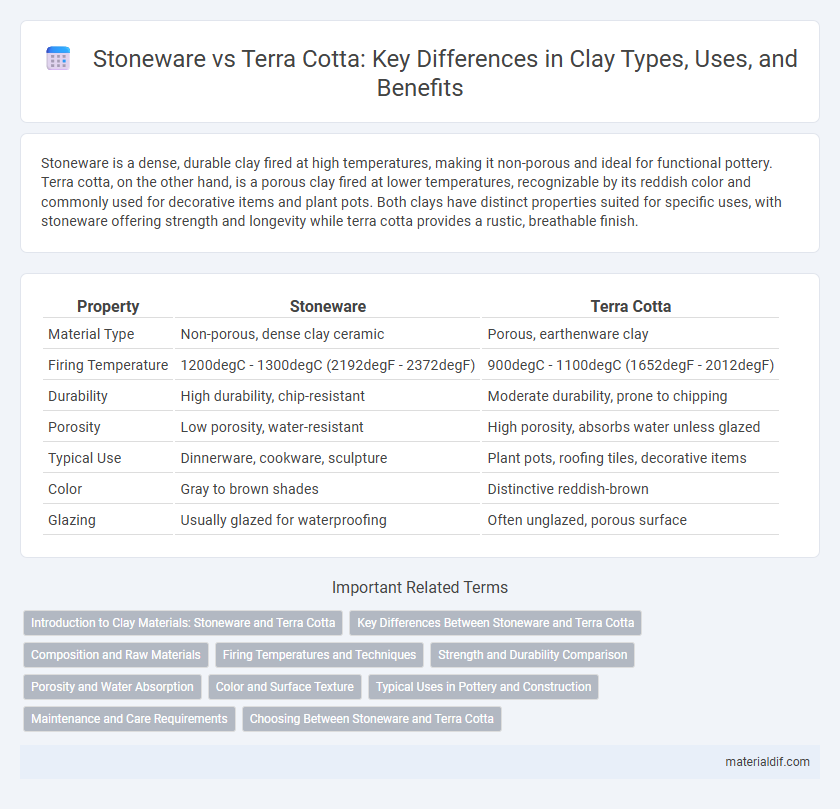Stoneware is a dense, durable clay fired at high temperatures, making it non-porous and ideal for functional pottery. Terra cotta, on the other hand, is a porous clay fired at lower temperatures, recognizable by its reddish color and commonly used for decorative items and plant pots. Both clays have distinct properties suited for specific uses, with stoneware offering strength and longevity while terra cotta provides a rustic, breathable finish.
Table of Comparison
| Property | Stoneware | Terra Cotta |
|---|---|---|
| Material Type | Non-porous, dense clay ceramic | Porous, earthenware clay |
| Firing Temperature | 1200degC - 1300degC (2192degF - 2372degF) | 900degC - 1100degC (1652degF - 2012degF) |
| Durability | High durability, chip-resistant | Moderate durability, prone to chipping |
| Porosity | Low porosity, water-resistant | High porosity, absorbs water unless glazed |
| Typical Use | Dinnerware, cookware, sculpture | Plant pots, roofing tiles, decorative items |
| Color | Gray to brown shades | Distinctive reddish-brown |
| Glazing | Usually glazed for waterproofing | Often unglazed, porous surface |
Introduction to Clay Materials: Stoneware and Terra Cotta
Stoneware and terra cotta are two primary types of clay materials used in ceramics, each with distinct firing temperatures and properties. Stoneware is fired at high temperatures, typically between 1,200degC and 1,300degC, resulting in a dense, durable, and non-porous material ideal for functional pottery. Terra cotta, fired at lower temperatures around 1,000degC to 1,150degC, is more porous and characterized by its warm reddish-brown color, commonly used for decorative and architectural applications.
Key Differences Between Stoneware and Terra Cotta
Stoneware is a dense, non-porous ceramic fired at high temperatures ranging from 1,200degC to 1,315degC, making it durable and chip-resistant, whereas terra cotta is a porous, reddish-brown clay fired at lower temperatures around 1,000degC to 1,150degC, resulting in a softer, more fragile material. Stoneware typically features a smooth, vitrified surface suitable for functional pottery and dinnerware, while terra cotta's porous texture is ideal for decorative items and plant pots that require breathability. The chemical composition of stoneware clay includes higher amounts of feldspar and kaolin compared to terra cotta, which relies more heavily on iron oxide for its characteristic color.
Composition and Raw Materials
Stoneware is made from a blend of clay, quartz, and feldspar, which creates a dense, vitrified material fired at high temperatures around 1,200 to 1,300degC. Terra cotta primarily consists of porous, iron-rich clay that fires at lower temperatures between 1,000 and 1,150degC, resulting in its characteristic reddish color. The raw material composition significantly influences their durability, water absorption, and suitability for different pottery and construction applications.
Firing Temperatures and Techniques
Stoneware is fired at high temperatures typically between 1,200degC and 1,300degC, resulting in a dense, vitrified, and durable ceramic body resistant to water and chipping. Terra cotta is fired at lower temperatures, around 1,000degC to 1,150degC, producing a more porous, softer clay that retains a characteristic reddish hue due to its iron content. The higher firing temperature of stoneware requires a controlled kiln environment to achieve vitrification, while terra cotta's lower firing allows for more traditional and fuel-efficient wood or gas kiln techniques.
Strength and Durability Comparison
Stoneware exhibits superior strength and durability compared to terra cotta, making it ideal for functional pottery and dinnerware that withstands daily use. Its dense, vitrified body resists chipping, cracking, and water absorption, unlike terra cotta, which is more porous and fragile. Terra cotta remains popular for decorative objects and outdoor planters due to its rustic aesthetic but requires sealing to enhance its durability.
Porosity and Water Absorption
Stoneware exhibits low porosity and minimal water absorption, typically under 1%, making it highly durable and suitable for functional pottery and dinnerware. Terra cotta, characterized by higher porosity and water absorption rates ranging from 10% to 20%, is more porous and less water-resistant, often requiring glazing to prevent moisture penetration. The difference in firing temperature and clay composition primarily influences their porosity, with stoneware fired at higher temperatures producing a denser, less absorbent material compared to the more porous, lower-fired terra cotta.
Color and Surface Texture
Stoneware typically exhibits a dense, non-porous surface with a smooth texture and varies in color from gray to brown, often with natural, earthy undertones. Terra cotta features a porous, slightly rough texture and is recognized for its warm, reddish-orange hue due to its iron-rich clay composition. These distinct differences in color and surface texture influence their aesthetic applications and durability in ceramics.
Typical Uses in Pottery and Construction
Stoneware is commonly used for durable pottery items like dinnerware, mugs, and storage jars due to its high firing temperature that makes it non-porous and strong. Terra cotta is typically favored for decorative pottery, garden pots, and architectural elements such as roof tiles and bricks, valued for its porous nature and warm, earthy color. In construction, terra cotta's breathability suits ventilation and facade cladding, whereas stoneware's hardness and water resistance make it ideal for functional ceramic tiles and heavy-duty applications.
Maintenance and Care Requirements
Stoneware requires minimal maintenance due to its dense and non-porous nature, making it resistant to stains and water absorption. Terra cotta, being porous, needs regular sealing and careful handling to prevent cracking and moisture damage. Both materials benefit from gentle cleaning with mild soap and avoiding harsh scrubbing to preserve their durability and appearance.
Choosing Between Stoneware and Terra Cotta
Choosing between stoneware and terra cotta depends on the desired durability and porosity for your project. Stoneware offers a dense, non-porous surface that is ideal for functional pottery and kitchenware, resisting chipping and absorbing moisture. Terra cotta, characterized by its porous texture and earthy red color, excels in decorative pieces and plant pots where breathability and rustic aesthetics are prioritized.
Stoneware vs Terra Cotta Infographic

 materialdif.com
materialdif.com